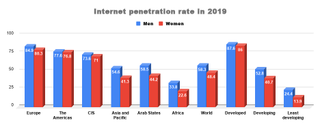Affordability and lack of skills are key reasons for widening digital gender gap
58.5% of men in Arab countries use the internet compared to 44.2% of female and the gender gap is widening

Affordability and lack of digital skills are the stumbling blocks for the widening digital gender gap globally despite the growth in usage of internet.
According to a new data released by International Telecommunication Union’s Measuring digital development series, about 52% of the global female population is still not using the internet, compared to 42% of all men, except the Americas, which has near-parity.
The data show that while the digital gender gap has been shrinking in the Commonwealth of the Independent States and Europe, it is growing in Africa, the Arab States and the Asia-Pacific region. It is widest in developing countries, especially least developed countries.
In the Arab countries, 58.5% of men are using the internet compared to 44.2% of female and that gender gap has been growing.
An estimated 4.1 billion people or 53.6% of the global population are using the internet in 2019, reflecting a 5.3% increase compared with 2018.
The global penetration rate increased from nearly 17% in 2005 to over 53% in 2019.
In developed countries, most people are online, with close to 87% of individuals using the internet. In the least developed countries, on the other hand, only 19% of individuals are online in 2019. Europe is the region with the highest internet usage rates (82.5%), Africa has the lowest internet usage at 28.2%.
Are you a pro? Subscribe to our newsletter
Sign up to the TechRadar Pro newsletter to get all the top news, opinion, features and guidance your business needs to succeed!
However, an estimated 3.6 billion people remain offline, with the majority of the unconnected living in the least developed countries where an average of just two out of every ten people is online.
- UAE ranked fourth globally in mobile broadband speed test in September
- Top five trends that will shape the technology sector in UAE in 2020
- Regulation and education are biggest barriers to digital transformation

Multi-stakeholder collaboration will be key
“Connecting the offline people to the power of digital technologies must become one of our most urgent development priorities,” said Doreen Bogdan-Martin, Director of ITU's Telecommunication Development Bureau.
However, she said that multi-stakeholder collaboration will be key to making universal and meaningful connectivity a reality for all.
“It will require targeted efforts to lower the cost of broadband and innovative policies to finance network rollout to unconnected populations,” she said.
The CIS region has the lowest broadband prices, while in Africa mobile broadband bundles are the most expensive.
By the end of 2019, ITU estimates that 57% of households globally will have internet access at home. However, the number of households with a computer at home is only expected to rise by about one percentage point to 49.7%, between 2018 and 2019.
Bogdan-Martin said that slowing growth in domestic computer ownership is accounted for by the fact that in many countries computers are no longer needed for home internet access, with people simply connecting over smartphones.
Women have fewer mobile phones than men
ITU data show that 96% of the world population now lives within reach of a mobile cellular signal and 93% within reach of a 3G (or higher) network.
In the Americas, the Asia-Pacific region and Europe, over 95% of the population is covered by a 3G or higher mobile broadband network. In the Arab States the figure stands at 91%; the Commonwealth of Independent States, 88%; and Africa, 79%.
Of the 85 countries that provided data on mobile phone ownership, 61 have a higher proportion of men with mobile phones than women.
Of the 24 remaining countries where there is gender parity in mobile phone ownership, or where more women have mobile phones than men, Chile has the highest digital gender gap in favour of women at 12%.
ITU data confirm a correlation between the mobile phone ownership gender gap and the Internet gender gap: countries where the mobile phone ownership gender gap is large also have a high number of women not using the internet.
“Given that mobile phones are the most-often used means of accessing the Internet, addressing the issue of women's mobile phone ownership could help reduce the internet gender divide,” Bogdan-Martin said.
She said that cultural, affordability and lack of digital skills remain some of the key barriers to the uptake and effective use of the internet, especially in the world's least developed countries.
Developing digital skills is top priority
In 40 out of 84 countries for which data are available, less than half the population has a basic computer skill, such as copying a file or sending an e-mail with an attachment.
In 60 of the countries for which data are available, these proportions are below 50%. Concerning advanced computer skills, she said that in only two countries (UAE and Brunei Darussalam) do more than 15% of people reported to have written a computer program using a specialised programming language in the last three months.
Although more data are needed, she said that initial findings indicate a strong and pressing need for governments to focus on measures to develop digital skills, particularly in the developing world.
“Even where connectivity exists, we need to be more creative in addressing critical issues like the affordability of service, cost of handsets and lack of digital skills and literacy to enable more people – and especially women – to participate and flourish in the digital economy,” Bogdan-Martin added.
